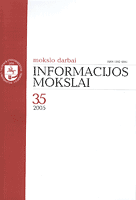Technologinių naujovių iššūkiai ir tradicinės televizijos kaita
Challenges of Technological Innovations and Change of Traditional Television
Author(s): Žygintas PečiulisSubject(s): Economy
Published by: Vilniaus Universiteto Leidykla
Summary/Abstract: Ways of traditional television broadcasting have been improved constantly. After intercontinental satellites were developed, interchange of programs strengthened oneness feeling of the world. Satellites of direct broadcasting have let stretch state borders. Plenty of programs, variety of broadcasting methods (surface, satellite, cable) started dividing mass audience into smaller fragments. Implementation of digital technologies, TV broadcasting through fixed-connection networks, mobile networks, possibility to watch programmes in moving objects evoked revolutionary variations of traditional television. Traditional television integrated into internet and mobile networks adapts to new communication conditions. New technologies change conception of television as a mean of mass communication. Next to the simultaneously broadcasted and accepted flow of programmes other transmission methods are possible: choice of programmes preserved on the hard disk or in a server, a possibility to order prepared episodes. Content of audiovisual production is applied to new watching conditions: compact fast loading webisodes for internet, macro images from different sides for mobile phones. Features of traditional media, skills of mass and interpersonal communication merge in terminals of hybrid communication. There are some already visible and predictive features of a new integrated communication channel: – with the help of different hypertext links a consumer may use primary and interpreted information; – watching and reading are becoming identical activities; – traditional media changes, because flow of audiovisual programs is archived and written media, in contrary, becomes a constantly renewed stream; – conception of periodicality changes, real, present and past time exists simultaneously; – mobility changes habits of TV show watching, in this way stimulating demand of new content; – skills formed by internet and mobile communication services let create new forms of audiovisual communication and self-expression (video diaries – moblogs, affinity, quarter television); – new communication possibilities stimulate creating third type of audiovisual broadcasting (next to commercial and public) – citizen channel characterized by independent audiovisual creation and interpersonal communication; – regulation problems of new content emerge, because the content being transmitted has features of traditional media, public service and personal communication.
Journal: Informacijos mokslai
- Issue Year: 2006
- Issue No: 36
- Page Range: 83-94
- Page Count: 12
- Language: Lithuanian

